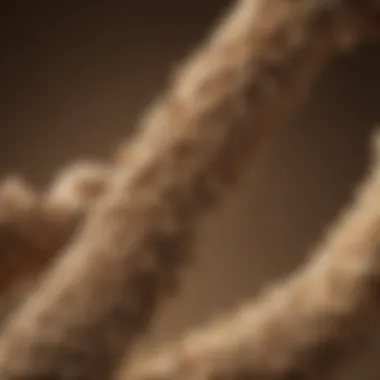Effective Strategies for Mycotoxin Removal and Challenges


Intro
Mycotoxins are harmful compounds produced by certain fungi, primarily affecting crops and food products. Their presence is a significant concern, as they pose health risks to humans and animals alike. Understanding the methods for removing these toxins is essential for ensuring food safety and environmental health. This article delves into various strategies, challenges, and advancements associated with mycotoxin removal, providing a comprehensive guide for researchers, educators, and industry professionals.
Research Overview
Summary of Key Findings
Mycotoxins can be categorized into several types, each with unique properties and health implications. Current research focuses on identifying effective removal strategies, which can be broadly divided into physical, chemical, and biological methods. Each method encompasses specific techniques, such as adsorption, degradation, and detoxification.
Key findings indicate that while physical methods like heat treatment and adsorption using activated carbon are effective, they may not fully eliminate mycotoxins. Additionally, biological methods involving fungi and bacteria have shown promise in degrading these toxic compounds. Recent advances have also introduced innovative techniques such as the use of nanomaterials, which enhance the efficiency of mycotoxin removal processes.
Importance of the Research
The relevance of mycotoxin research transcends academia. For professionals involved in food production and safety, understanding mycotoxin removal is critical. Not addressing this issue could lead to significant health risks and economic losses. Regulatory standards continue to evolve, highlighting the need for effective mitigation strategies. Moreover, future research may lead to novel approaches that enhance mycotoxin detection and removal, ensuring safer food supplies for consumers.
Methodology
Study Design
This research adopts a comprehensive approach, encompassing both qualitative and quantitative methods. By analyzing existing literature and performing experimental studies, the article aims to provide a well-rounded understanding of the mycotoxin removal landscape.
Data Collection Techniques
Data is gathered through a variety of sources. Primary data is obtained via laboratory experiments, while secondary data is derived from scholarly articles, regulatory documents, and industry reports. This dual approach allows the research to cross-reference findings and validate results effectively.
Important: Continuous monitoring and analysis of mycotoxin levels in food products are imperative. Adaptative strategies are necessary to cope with emerging mycotoxin types and their resistance to common removal approaches.
Understanding Mycotoxins
Mycotoxins are toxic compounds that result from the metabolic processes of certain fungi. Understanding them is essential because they pose substantial health risks to both humans and animals. Numerous food products and agricultural commodities can be contaminated, leading to economic loss and health issues across various populations. By grasping the fundamental aspects of mycotoxins, we can appreciate the necessity of effective removal strategies.
Definition and Classification
Mycotoxins are secondary metabolites produced by various species of fungi. These compounds can be classified into several categories based on their chemical structure and biological effects. Key classifications include:
- Aflatoxins: Produced primarily by Aspergillus species, these are among the most potent carcinogens known.
- Ochratoxins: These toxins, predominantly derived from Aspergillus and Penicillium species, can lead to kidney damage and have potential carcinogenic properties.
- Fumonisins: Often produced by Fusarium species, they are linked to serious health conditions such as esophageal cancer and neural tube defects.
- Trichothecenes: Another group from Fusarium, characterized by their ability to inhibit protein synthesis within cells.
Understanding these definitions and classifications helps in identifying the specific risks associated with each type of mycotoxin and informs the appropriate removal methodologies.
Sources and Occurrence
Mycotoxins are found in a variety of environmental settings. Common sources include:
- Crops: Cereals like corn, wheat, and barley can become contaminated at any phase, from growth to storage.
- Food Products: Processed foods, nuts, fruits, and even dairy products can harbor mycotoxins.
- Fungal Infections: Fungi thrive in humid conditions, making warm, moist environments ideal for contamination.
The occurrence of these toxins is not only geographical but also seasonal, with specific climates fostering higher levels of fungal growth. Awareness of where and how mycotoxins arise informs preventive measures in agriculture and food production.
Health Implications
The health implications of mycotoxins are severe and multifaceted. Short-term exposure can lead to acute toxic effects, with symptoms ranging from gastrointestinal distress to immune system suppression. Long-term effects are even more concerning; chronic exposure is linked to severe health outcomes, including cancer, liver damage, and developmental issues in children.
"Effective control of mycotoxin contamination is crucial for public health and food safety."
In summary, understanding mycotoxins encompasses their definition, sources, and health risks. Such knowledge forms the foundation for developing robust strategies for removal and mitigation. The significance of addressing mycotoxins is evident in our food systems and public health initiatives.


The Need for Mycotoxin Removal
Mycotoxin removal has become a critical focus in food safety and public health due to the significant risks posed by these toxic fungi-derived compounds. Every year, mycotoxins contaminate a wide range of food products, impacting humans and animal health adversely. Effective mycotoxin removal processes not only protect consumer health but also ensure food integrity and industry stability. Understanding the necessity for these removal techniques is paramount.
Economic Impact
The economic impact of mycotoxin contamination is profound. It affects various sectors, including agriculture, food processing, and even trade. Farmers suffer losses when crops are rejected due to contamination, as they cannot sell tainted products in the market. This loss is not just in monetary terms but also affects farmers' livelihoods and economies—especially in developing regions where agriculture forms the backbone of the economy.
Mycotoxins lead to significant healthcare costs as they contribute to diseases requiring treatment. Affected populations may face increased medical expenses, subsequently straining public health systems.
Moreover, consumers are increasingly aware of food safety issues, leading to a demand for cleaner products. Companies that fail to address mycotoxin risks may face backlash, resulting in lost consumer trust and potential legal implications. This dynamic emphasizes the need for robust mycotoxin removal strategies, not merely as a regulatory compliance measure but as a means to maintain economic viability.
Regulatory Frameworks
Regulatory frameworks in various regions address mycotoxin contamination, setting permissible levels for different compounds. For instance, the European Union and the United States actively monitor mycotoxin levels in food products to safeguard public health. These regulations create standards that producers must follow, ensuring consumer safety. However, adhering to these standards can impose additional costs on manufacturers.
Compliance with these regulations often demands sophisticated testing and removal techniques. For example, regulations require rigorous testing protocols before products reach consumers. This complexity can increase production costs but is essential for regulatory compliance and marketability.
Countries lagging in implementation may face trade barriers, as imported goods are scrutinized for compliance with established mycotoxin limits. Thus, understanding regulatory frameworks is crucial not only for safety but also to support international commerce.
"Effective mycotoxin removal is not only about health safety; it is a pivotal economic strategy that influences agricultural sustainability and market competitiveness."
Successful removal of mycotoxins aids in adhering to regulations, reducing economic losses, and ensuring healthier food products. As our understanding of mycotoxins evolves, so does the importance of effective removal methodologies, reinforcing their necessity in the global food supply chain.
Methods of Mycotoxin Removal
The process of mycotoxin removal is crucial for ensuring the safety of food and feed. Mycotoxins pose a serious threat to health, making their elimination a top priority. Various methods have developed over the years, each with unique strengths and weaknesses. Understanding these methods allows for better decision-making and strategy formulation in mitigating mycotoxin risks effectively.
Physical Methods
Filtration
Filtration is a physical method that involves separating particles from liquids or gases. In the context of mycotoxin removal, it is particularly valued for its efficiency in eliminating larger mycotoxin-associated particles. Filtration is a beneficial choice as it can be easily integrated into existing systems without extensive modifications. One key characteristic of filtration is its ability to work without chemical additives, allowing for clean removal processes. However, its unique feature lies in limited effectiveness against smaller mycotoxins, necessitating the need for supplementary methods.
Adsorption
Adsorption involves the adhesion of molecules from a gas or liquid to a solid surface. It is frequently employed in removing mycotoxins due to its efficiency and selective characteristics. An example of a solid used in this technique is activated charcoal, which provides a large surface area for binding mycotoxins. Adsorption is a popular choice for mycotoxin removal because it can reduce mycotoxin concentrations to very low levels. However, a disadvantage is the potential for saturation of adsorbent materials, which can limit its effectiveness over time.
Heat Treatment
Heat treatment involves exposing materials to high temperatures, effectively killing fungi and degrading mycotoxins. This method is effective against numerous mycotoxins and is often seen in food processing. The principal characteristic of heat treatment is its ability to achieve significant reductions in mycotoxin levels. Many processors prefer this method for its straightforward application. However, not all mycotoxins are heat-stable, and some may require very high temperatures, which can potentially affect the nutritional value of food products.
Chemical Methods
Chemical Detoxification
Chemical detoxification employs chemical agents to neutralize or transform mycotoxins into less harmful substances. This method is essential for treating contaminated materials effectively. Its advantage lies in the ability to target specific mycotoxins for removal. It is popular mostly in laboratory settings. Nonetheless, the main disadvantage is the potential for harmful residues if not correctly administered, raising concerns for food safety.
Solvent Extraction
Solvent extraction utilizes a solvent to dissolve and separate mycotoxins from contaminated substrates. This technique offers high efficiency in extracting mycotoxins from grains and other materials. It is a favored choice due to its adaptability in various industrial settings. An important feature of solvent extraction is its ability to recover valuable components while removing toxins. A downside, however, is that selecting the right solvent is vital; improper choices can lead to inadequate removal or toxic residue issues.
Biological Methods
Microbial Degradation
This method harnesses the capabilities of specific microorganisms to break down mycotoxins. Microbial degradation shows promise in providing a natural approach to mycotoxin removal. Its key characteristic is the ability of certain microbes to metabolize mycotoxins into harmless byproducts. This makes it an appealing option for sustainable practices. Its unique feature is the potential for tailored solutions using genetically engineered microbes. However, reliance on microbial activity can be unpredictable, and environmental variables may impact its efficiency.


Enzymatic Treatment
Enzymatic treatment uses specific enzymes to degrade mycotoxins. This method represents an advanced approach to detoxification and offers efficiency in targeting specific mycotoxins. The key characteristic of enzymatic treatment is the precision of actions, enabling breakdown of harmful compounds without affecting other components. While this method is beneficial, a challenge lies in the cost of enzymes and the need for controlled conditions for maximum efficacy.
Comparative Analysis of Removal Techniques
The comparative analysis of mycotoxin removal techniques is crucial for understanding the effectiveness, cost-efficiency, and environmental impact of various strategies. With mycotoxins being a significant threat to health and safety, selecting the right approach for their removal is essential. This section offers a deep dive into three core aspects: efficiency assessment, cost analysis, and environmental considerations, enabling researchers, educators, and professionals to navigate the complexities of mycotoxin mitigation.
Efficiency Assessment
Efficiency assessment is the backbone of evaluating any mycotoxin removal technique. It pertains to the ability to remove or reduce mycotoxin levels in various substrates effectively. Different methods—physical, chemical, and biological—exhibit varying levels of efficiency depending on the context. For example, heat treatment can be exceptional for certain mycotoxins like aflatoxins, while adsorption methods can offer good results across a broader spectrum of toxins.
Through assessment, one might use criteria such as:
- Removal rates: Effectiveness in achieving target concentrations
- Time required: Speed of the process in real applications
- Material compatibility: Interaction with the substrate and potential degradation
Research studies often provide comparative data to support these assessments. Methodical experimentation can reveal insights into how different techniques stack up against one another under similar conditions. Understanding these efficiencies helps guide the selection process for different industrial applications.
Cost Analysis
Cost analysis plays a significant role in decision-making about which mycotoxin removal strategy to adopt. Although a method may efficiently remove toxins, its feasibility can be undermined by high operational costs. Cost factors to consider include:
- Initial investment: Expenses for equipment and setup
- Operating costs: Energy consumption, labor, and maintenance expenses
- Material costs: Pricing of adsorbents or reagents used in processes
For instance, a sophisticated biological method leveraging specific enzymes may offer effective detoxification but at a higher operational cost compared to a straightforward physical method like filtration. A thorough cost analysis allows stakeholders to make informed choices, balancing effectiveness against budget constraints.
Environmental Considerations
The environmental impact of mycotoxin removal techniques cannot be overlooked. As societal awareness continues to rise regarding sustainability, the long-term effects of chosen methods on the surroundings come into play. Key points within this discussion include:
- Waste generation: Evaluation of residual materials post-treatment
- Chemical use: Consideration of toxic or hazardous substances that may contaminate ecosystems
- Energy consumption: Assessment of the carbon footprint associated with processing methods
For example, certain chemical detoxification processes may produce harmful by-products, necessitating additional steps for waste management. Alternatively, biological methods can be more environmentally benign but may yield lower removal efficiencies.
In sum, a comparative analysis of mycotoxin removal techniques presents a multidimensional evaluation framework. Through examining efficiency, cost, and environmental impact, stakeholders can make decisions that maximize benefits while minimizing drawbacks. This approach ensures a holistic understanding of the challenges and strategies in combating mycotoxin contamination.
Challenges in Mycotoxin Removal
Mycotoxin removal is fraught with intricate challenges that impede effective mitigation strategies. Understanding these challenges is essential for developing comprehensive solutions. Mycotoxins, the toxic compounds produced by certain fungi, are resilient and persist in various environments. This resilience complicates removal efforts, creating a need for targeted strategies that address specific mycotoxins. Furthermore, cost-effectiveness and regulatory compliance emerge as significant considerations that stakeholders must navigate.
Resistance to Removal Techniques
One of the foremost hurdles in mycotoxin removal is the inherent resistance of mycotoxins to conventional removal techniques. Each type of mycotoxin possesses unique chemical structures that respond differently to various mitigation methods. For instance, aflatoxins are notoriously stable under standard processing temperatures. This stability often results in inadequate removal during purification processes, even when employing advanced methodologies such as filtration or adsorption.
Researchers are continually seeking more effective techniques. However, the challenge persists as some removal methods could inadvertently lead to the transformation of these toxins into other harmful compounds. This cycle of resistance heightens the complexity of the problem and underscores the necessity for continued research and innovation in the field.
Cost-Effectiveness Balance
Balancing effectiveness against cost is another prominent challenge in mycotoxin removal. While some advanced technologies may demonstrate superior efficacy, they often come with significant financial implications. For industries relying on agricultural outputs, the additional costs of implementing sophisticated removal methods can be prohibitive.
Practitioners must therefore consider not only the potential benefits of a removal technique but also its economic impact. This necessitates a thorough cost-benefit analysis to establish whether the increased expenditure justifies the expected health and safety benefits. Consequently, industries may find themselves in a dilemma: opt for budget-friendly solutions that might not fully eliminate mycotoxins or invest in more effective approaches that could strain their financial resources.
Regulatory Compliance
Compliance with regulatory frameworks is yet another intricate layer of challenge in mycotoxin removal. Regulatory bodies worldwide have established stringent guidelines regarding permissible mycotoxin levels in food and feed products. Adhering to these regulations demands consistent monitoring and testing throughout production processes, which can be resource-intensive.
Moreover, regulations may vary significantly across regions. This variability poses a challenge for global supply chains, as products must meet different requirements depending on their geographical market. As industries strive to ensure compliance, they face the challenge of developing strategies that not only adhere to these regulations but are also effective in mitigating the harmful effects of mycotoxins.


"The removal of mycotoxins presents a multi-faceted challenge, merging scientific, economic, and regulatory complexities."
Innovations in Mycotoxin Mitigation
Innovations in mycotoxin mitigation are critical in the ongoing battle against the health risks posed by these toxic substances. As the understanding of mycotoxins evolves, so too must the strategies employed to remove or deactivate them. Effective innovation in this domain involves both the development of new technologies and substantial research advancements. Each of these elements plays a pivotal role in enhancing current practices and addressing the limitations that existing methods present.
Significantly, these innovations can potentially reduce health risks for consumers and improve food safety standards globally. They also aim to provide cost-effective solutions that can be integrated into various agricultural and industrial settings.
"Continuous research is essential to uncover new methods and technologies for effective mycotoxin removal."
Emerging Technologies
Emerging technologies in the realm of mycotoxin mitigation encompass a range of approaches that harness scientific advancements. These technologies are designed for improved efficiency and effectiveness in reducing mycotoxin levels. Some notable examples include:
- Nanotechnology: Utilizes nanoparticles to bind with mycotoxins, rendering them less harmful. This method shows promise in enhancing the adsorption capacity of existing materials.
- Advanced Filtration Systems: Innovations in filtration technology can capture mycotoxins more effectively, often integrating multiple filtration mechanisms to target various toxic compounds simultaneously.
- Real-Time Monitoring Systems: Employing sensors and AI algorithms allows for immediate detection of mycotoxins in food products. This proactive approach aids in timely intervention, minimizing the risk of contamination.
These technologies not only enhance the efficiency of removal methods but also offer the potential for more sustainable practices in food production and storage.
Research Developments
Research continues to shed light on the mechanisms of mycotoxin toxicity and the effectiveness of various mitigation strategies. Recent developments emphasize the importance of interdisciplinary approaches. For instance:
- Genetic Studies: Analyzing the genomic characteristics of fungi that produce mycotoxins can lead to the development of resistant crops, reducing the incidence of contamination at the source.
- Microbial Interventions: Research into using beneficial microorganisms for bio-remediation is gaining traction. These microorganisms can degrade mycotoxins, transforming them into non-toxic compounds.
- Chemical Innovations: Studies exploring novel chemical agents that can detoxify mycotoxins present new options for food processing industries. These agents could be safer alternatives compared to traditional chemical methods.
Ultimately, these research developments illuminate viable pathways for enhancing food safety and health outcomes, while concurrently addressing the challenges posed by mycotoxins.
In summary, both emerging technologies and active research efforts are reshaping the landscape of mycotoxin mitigation. As these innovations unfold, they provide valuable insights into how to combat the pervasive threat of mycotoxins effectively.
Future Directions in Mycotoxin Research
The exploration of future directions in mycotoxin research plays a crucial role in shaping effective strategies for their removal. As the knowledge of mycotoxins deepens, new avenues for research emerge, focusing on integrating various methodologies and enhancing regulatory frameworks. Addressing mycotoxin contamination is not only about identifying and removing these harmful compounds but also about understanding their complex interactions within ecosystems and human health.
Integrative Approaches
Integrative approaches to mycotoxin research encompass a multidisciplinary perspective. Researchers consider various aspects such as biological, technological, and environmental dimensions. A vibrant field emerging from this is the use of advanced analytics and bioinformatics to enhance detection methods. Techniques like next-generation sequencing can provide insights into fungal species producing mycotoxins and their adaptation mechanisms. Moreover, the implementation of nanotechnology in mycotoxin detection exhibits significant potential.
Combining strategies from agriculture, food science, and toxicology can lead to holistic solutions. For instance, using resistant crop varieties can minimize fungal contamination from the start. Furthermore, exploring the synergistic effects of different removal methods could yield higher efficiencies in mycotoxin mitigation. With collaborative efforts among researchers, industries, and regulatory bodies, integrative approaches can lead to meaningful advancements in mycotoxin management.
Policy Implications
Policy implications in mycotoxin research can greatly influence the effectiveness of removal strategies. Regulatory frameworks must be adaptive, reflecting the evolving nature of mycotoxin research. Policymakers need to consider not only safety standards but also the economic repercussions of implementing stringent regulations. Flexibility in guidelines allows researchers to innovate while still maintaining public health safeguards.
Global cooperation is essential. Sharing data and best practices across borders can lead to more effective management strategies. It is also vital to engage stakeholders at every level, from farmers to industry leaders, to ensure that the end policies are pragmatic and implementable. Effective policies encourage research funding and a supportive environment for new technologies and approaches.
"A unified approach in policy can drive substantial progress in combating mycotoxin risks, fostering innovation and collaboration across sectors."
In summary, future directions in mycotoxin research hinge on integrative methodologies and robust policy frameworks. Emphasizing collaboration and adaptability will enhance our capacity to tackle the complex challenge posed by mycotoxins, ultimately ensuring healthier outcomes for humans and animals alike.
Finale
The discussion of mycotoxin removal encapsulates vital elements that extend beyond mere mitigation processes. This article has systematically traversed the landscape of mycotoxin contamination, highlighting the inherent complexity associated with its removal. From the health risks posed by mycotoxins to the extensive range of removal strategies—including physical, chemical, and biological methods—understanding this multifaceted issue is imperative for health safety.
Each approach to mycotoxin removal presents unique advantages and challenges. Physical methods, while often straightforward, can fail to eliminate all contaminant types. In contrast, biological techniques, such as enzymatic treatment, show promise but may not be universally applicable. Thus, it is crucial for researchers and practitioners in the field to remain cognizant of these factors when choosing removal strategies.
Moreover, the importance of regulatory frameworks cannot be overstated. Compliance with standards such as those set by the Food and Drug Administration and the European Food Safety Authority ensures that mycotoxicological risks are managed effectively. Failure to adhere to these regulations could have dire consequences, not only for public health but for economic stability in agricultural sectors.
In addition to regulatory compliance, innovations and research must be continuously pursued. Emerging technologies can redefine existing methodologies and lead to breakthroughs in detecting and removing mycotoxins.
"Investing in research and development is critical for improving mycotoxin mitigation efforts and informing policy decisions on health safety."
Finally, as the future directions in mycotoxin research unfold, integrative approaches that unite different methodologies along with holistic policies will ultimately enhance the effectiveness of removal processes. The challenge lies in striking a balance between cost-effectiveness and safety standards.
These aspects solidify the necessity of an informed and collaborative response to mycotoxin contamination. In summary, vigilance, adaptation, and innovation will form the cornerstone of successful mycotoxin removal strategies.



